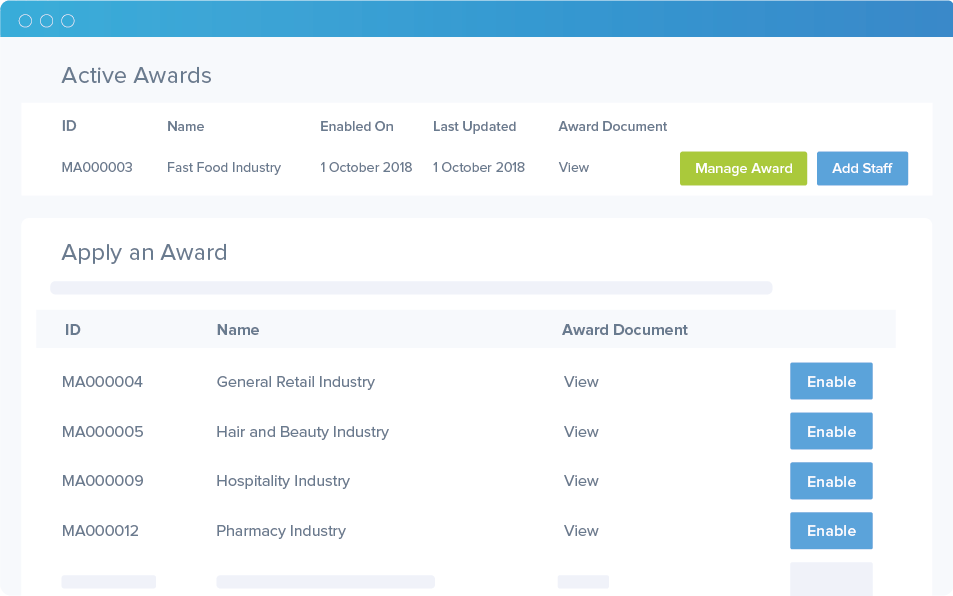Childcare is one of Australia’s biggest industries, with nearly 130,000 workers looking after about 1.5 million children. In recent years, the Federal Government has moved to subsidise childcare to help almost a million families who use the system. A number of proposals have also been made to increase pay rates for workers. Currently, the pay and conditions for workers in the sector is governed by the Children’s Services Award 2010 MA000120. Tanda has prepared a comprehensive guide to help you understand the award.
About the Children’s Services Award
The modern award system is designed to give a fair wage to employees in Australia’s biggest industries. The Fair Work Commission has hearings every year to decide what the pay rates should be for different awards. Because of variation in the profitability and types of work in each industry, the rates vary across sectors.
The Children’s Services Award 2010 MA000120 covers all employees employed in childcare, including daycare, nurseries, family-based childcare, out of school hours care, kindergartens and pre-schools. Entitlements under the award vary by skill and experience level. A full definition of the scope of the award can be found via the Fair Work Commission under “3. Definitions and Interpretations”.
The complexity of The Award System
The industrial relations framework in Australia is designed to make sure all employees get a fair go at work, and takes into account all sorts of different types of work to create different pay rates. Because of this, the award system can be extremely complicated for businesses to interpret. Each award, including the Children’s Services Award, can have between 180-200 individual rules, covering overtime hours, shift breaks, RDO overtime, public holidays and late-night shifts.
Tanda has been helping businesses that employ workers under the Children’s Services Award across the country make sure they roster and pay their staff correctly for a number of years. Take a look at some of the businesses we’ve helped navigate the system here.
Children’s Services Award 2010 pay rates
Below are the minimum general Children’s Services Award pay rates for 2022 for the various levels of employment. The current rule set came into effect on the 1st of July 2021.
| Level | Hourly Pay | Saturday | Sunday | Public Holiday |
| Level 1 | $21.85 | $32.78 | $43.70 | $54.63 |
| Level 2 | $22.64 | $33.96 | $45.28 | $56.60 |
| Level 3 | $24.76 | $37.14 | $48.76 | $60.95 |
| Level 4 | $26.79 | $39.63 | $52.84 | $66.05 |
| Level 5 | $30.50 | $45.75 | $61 | $76.25 |
| Director | $35.17 | $52.76 | $70.34 | $87.93 |
| Level | Hourly Pay | Saturday | Sunday | Public Holiday |
| Level 1 | $27.32 | $38.24 | $49.16 | $60.09 |
| Level 2 | $28.30 | $39.62 | $50.94 | $62.26 |
| Level 3 | $30.95 | $43.33 | $52.63 | $68.09 |
| Level 4 | $33.03 | $46.24 | $59.45 | $72.66 |
| Level 5 | $38.13 | $53.38 | $68.63 | $83.88 |
| Director | $43.96 | $61.55 | $79.13 | $96.72 |
Level | Hourly Pay | Saturday | Sunday | Public Holiday |
Level 1 | $19.81 | $27.74 | $35.66 | $43.59 |
Level | Hourly Pay | Saturday | Sunday | Public Holiday |
Level 1 | $15.85 | $23.78 | $31.70 | $39.63 |
Level | Hourly Pay | Saturday | Sunday | Public Holiday |
Level 1 | $22.64 | $31.69 | $40.75 | $49.80 |
Level | Hourly Pay | Saturday | Sunday | Public Holiday |
Level 1 | $18.11 | $27.17 | $36.22 | $45.28 |
Level | Hourly Pay | Saturday | Sunday | Public Holiday |
Level 1 | $25.48 | $35.67 | $45.86 | $56.05 |
Level | Hourly Pay | Saturday | Sunday | Public Holiday |
Level 1 | $19.81 | $27.74 | $35.66 | $43.59 |
Keeping compliant with Fair Work legislation
In recent years, businesses have increasingly automated their interpretation of awards because of the complexity of Australia’s industrial relations framework. Many businesses which used manual methods of calculating pay under the Children’s Services Award have had underpayment issues. In 2020, workers were underpaid to the tune of about $2.4 billion dollars. The biggest reason for underpayment isn’t that businesses are trying to scam workers – it’s the complexity of the award.
Workforce management software like Tanda records an employee’s time and attendance, and applies the appropriate pay rate, penalty rates, allowances and higher duties. Tanda manages a large number of awards including the Children’s Services Award with built in rates that sync with payroll, update on staff birthdays or when Fair Work rules change.

Classifying employees under the Childcare Award
One of the biggest reasons employers underpay staff is because they have been incorrectly classified. The rates and entitlements vary dramatically depending on what classification an employee is. Fair Work provides a complete guide on classifying staff. But, for a basic outline, see below:
FULL-TIME EMPLOYEES
- Usually works, on average, 38 hours each week.
- Can be a permanent employee or on a fixed-term contract.
PART-TIME EMPLOYEES
- On average work less than 38 hours per week.
- Commonly work regular hours each week.
- Can be a permanent employee or on a fixed-term contract.
CASUAL EMPLOYEES
- Are employed with the understanding that there is no firm advance commitment to ongoing work with an agreed pattern of work.
Casual conversion
The Australian Government recently introduced laws which allow eligible casual employees to convert to permanent employment. The laws were introduced to stop rare situations where casuals were working full-time for long periods of time without accruing leave. Employers need to make an offer of casual conversion if an employee has been at the business for at least a year and worked consistent hours in that time. For more information on casual conversion see Tanda’s complete guide on the topic.
The Childcare Award includes casual conversion and you’ll need to take this into account when rostering employees. If casuals are eligible to become permanent it also grants them additional entitlements such as annual leave and sick leave.
Penalties and allowances
Like most other awards, workers covered by the Children’s Services Award underare entitled to penalties and allowances under certain working conditions. Typically, penalty rates offer workers higher rates for working at inconvenient times, including weekends or at night (after 6PM). Workers are also eligible for overtime pay if they work longer than their rostered hours. Typically, overtime rates increase the more overtime an employee does in a shift.
In the Childcare Award, one of the most common penalties is a “split shift” allowance. A split shift is where an employee works two shifts in one day, separated by a break. For example, an employee might work in before school care from 6am to 9am, and again at after school care from 3pm to 6pm. An arrangement like this will see the worker pay a split shift “allowance”, which is a penalty for having a break throughout the day.
Children’s Services Award workers are also eligible for other allowances like laundry, clothing and meals. The interpretation of these allowances can be complicated and depends on the situation of your business.
Leave entitlements
Workers employed under the Children’s Services Award receive the same leave entitlements as the vast majority of employees in Australia. These are set out in the National Employment Standards (NES). The amount of leave is set out by the classification of the employee. Typically, casuals don’t receive annual leave entitlements, whereas part time and full time employees do.
FULL-TIME EMPLOYEES
- Are entitled to paid leave including annual leave and sick & carer’s leave.
PART-TIME EMPLOYEES
- Are entitled to paid leave including annual leave and sick & carer’s leave.
CASUAL EMPLOYEES
- Are not entitled to paid leave including annual leave and sick & carer’s leave.





